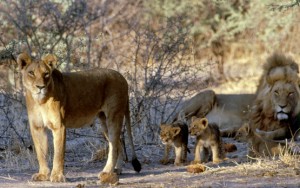News
Latest Lion Aid News
Does trophy hunting of lions contribute to their overall conservation?
Friday 12th November 2010
|
The causes for the continuing decline are considered due to conflict with expanding human and livestock populations, loss of natural prey base for lions, exposure to domestic animal diseases like canine distemper and bovine tuberculosis – but there is no mention of trophy hunting pressure. 4,249 LION TROPHIES EXPORTED BETWEEN 2002 AND 2008 Between 2002, when those latest surviving wild lion numbers were estimated, and 2008, when best reliable data from CITES export data for the continent ends, a total of 4249 “wild” lion trophies were exported. The category of “wild” lions is necessary as in South Africa, hunters who export trophies under CITES permits have the option of shooting captive-bred lions, a practice known as “canned” hunting. AN EXPORT OF 4,249 LION TROPHIES IS A SIGNIFICANT NUMBER Even if one takes the greatly optimistic total of 47,000 lions in Africa derived by Mr Chardonnet in 2002, an export of 4249 lions since then is significant. Hunters are largely prohibited from shooting females, would be embarrassed to bring home a trophy of a cub, and largely aim for males. Few wild lion males born reach adulthood – a difficult journey involving confrontations with resident pride males during their nomadic phase for example. In Botswana, about 15% of lions in an area are adult males – the prize trophies. That means in 2002, according to Mr Bauer and Mr Van der Merwe’s maximum lion estimates, there were 4500 potential adult male trophy lions in all Africa. By Mr Chardonnet’s estimates, there might have been 7000. Perhaps the hunters shot underage males, but still, 4249 exported lions imply a significant depredation. Many additional lions were probably shot, as domestic trophy hunting numbers are not recorded by CITES. WHERE WERE THESE LIONS SHOT? From 2002 to 2007, 1112 trophies were exported from Tanzania, 935 from South Africa, 459 from Zimbabwe, 283 from Zambia, and 97 from Mozambique as the top five exporting countries. According to the population numbers provided by Mr Bauer and Mr Van der Merwe, that would indicate that Tanzania exported 13% of their estimated 2002 population, South Africa 33%, Zimbabwe 32%, Zambia 14%, and Mozambique 11%. Lions simply cannot reproduce fast enough to maintain this level of offtake of adult males, meaning that the resource is being mined rather than sustainably utilized. No wonder that Mr Craig Packer of the University of Minnesota, in a research article, found that lion populations in areas where they were hunted declined faster than in areas where they were not. WHERE DID THE EXPORTED TROPHIES GO? Far over 2000 to the United States, over 300 to Spain, almost 200 each to France, Germany and Mexico. The UK imported 49 wild lion trophies between 2002 and 2008. Other countries where the trophy hunters mounted their lions were Sweden, Norway, Russia, Denmark, Portugal, Saudi Arabia, the United Arab Emirates – the list is long. CITES STATISTICS EXPOSE THE HUNTERS' SPIN Clearly, the CITES numbers tell a different story from the hunters spin. A species in freefall decline should not be subjected to additional mortality from trophy hunters. Lions have a complex social system in which males play a role to ensure survival of cubs. With that number of exports, significant reproductive difficulties can be predicted from disrupted prides. HOW DO WE ENSURE SURVIVAL OF LIONS IN AFRICA? To ensure survival of lions in Africa, much needs to be done. Populations in existing protected areas need to be carefully monitored. Additional legislated protected areas need to be revived in countries where past civil strife or current political instability has rendered those reserves defunct. Non-consumptive photographic tourism, though it brings along its own set of problems, remains an economic alternative to destructive hunting. And lions need a significantly increased level of range-state and international protection. TROPHY HUNTING OF LIONS MUST BE STOPPED While many factors surely add to the overall dramatic loss of lions in Africa, continued trophy hunting will not contribute to their long-term survival. The statistics about the number of glass-eyed lions adorning many walls tell the sad truth about hunting as a proposed conservation measure by vested interests. Categories: Trophy Hunting |
Posted by Pieter Kat at 16:11
No comments have been posted yet.
Add a new comment
Existing user
New user sign up




